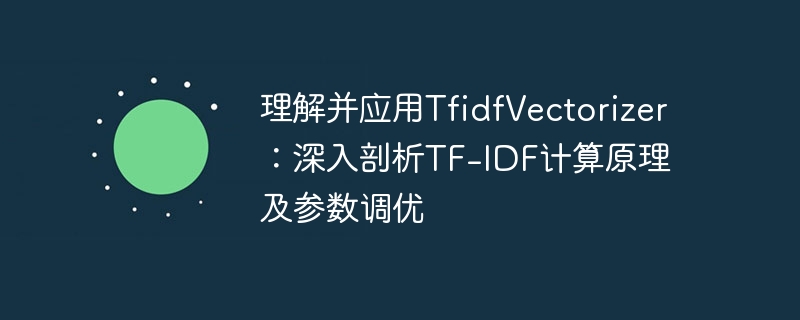TF-IDF原理与参数优化全解析
时间:2025-08-12 10:45:26 182浏览 收藏
一分耕耘,一分收获!既然都打开这篇《TF-IDF原理详解与参数优化指南》,就坚持看下去,学下去吧!本文主要会给大家讲到等等知识点,如果大家对本文有好的建议或者看到有不足之处,非常欢迎大家积极提出!在后续文章我会继续更新文章相关的内容,希望对大家都有所帮助!

本文旨在深入解析scikit-learn库中TfidfVectorizer的TF-IDF计算过程,重点阐述smooth_idf参数对IDF值的影响,并通过实例演示如何调整参数以获得期望的计算结果。同时,澄清TF计算中的常见误解,强调TF-IDF计算流程的整体性,帮助读者更准确地理解和运用TfidfVectorizer进行文本特征提取。
TfidfVectorizer是scikit-learn库中用于文本特征提取的强大工具,它将文本数据转换为数值型特征向量,便于机器学习模型处理。理解其内部的TF-IDF计算原理对于有效利用该工具至关重要。本文将深入探讨TfidfVectorizer的计算细节,重点关注smooth_idf参数的影响,并澄清TF计算的常见误区。
TF-IDF 原理
TF-IDF (Term Frequency-Inverse Document Frequency) 是一种常用的文本特征提取方法,用于评估一个词语对于一个文件集或一个语料库中的其中一份文件的重要程度。 TF-IDF 的主要思想是:如果某个词或短语在一篇文章中出现的频率 TF 高,并且在整个语料库中很少出现,那么认为此词或者短语具有很好的类别区分能力,适合用来分类。TF-IDF 实际上是:TF * IDF,其中 TF 衡量词语在文档中出现的频率,而 IDF 衡量词语在整个语料库中的稀有程度。
IDF计算中的smooth_idf参数
TfidfVectorizer中的IDF(Inverse Document Frequency,逆文档频率)计算公式默认包含一个平滑项,由smooth_idf参数控制。当smooth_idf=True时(默认值),IDF的计算公式如下:
IDF(t) = ln((1 + n) / (1 + df(t))) + 1
其中:
- n 是文档总数。
- df(t) 是包含词语 t 的文档数量。
smooth_idf 的作用是防止分母为零的情况,并平滑IDF值,使得罕见词语的IDF值不会过高。
示例:
假设我们有以下三个文档:
data = ['Souvenir shop|Architecture and art|Culture and history',
'Souvenir shop|Resort|Diverse cuisine|Fishing|Shop games|Beautiful scenery',
'Diverse cuisine|Resort|Beautiful scenery']如果我们要计算词语 "art" 的 IDF 值,它只出现在第一个文档中。
- n = 3 (文档总数)
- df("art") = 1 (包含 "art" 的文档数)
当 smooth_idf=True 时:
IDF("art") = ln((1 + 3) / (1 + 1)) + 1 = ln(2) + 1 ≈ 1.6931当 smooth_idf=False 时:
IDF("art") = ln(3 / 1) + 1 ≈ 2.0986代码演示:
from sklearn.feature_extraction.text import TfidfVectorizer
import numpy as np
data = ['Souvenir shop|Architecture and art|Culture and history',
'Souvenir shop|Resort|Diverse cuisine|Fishing|Shop games|Beautiful scenery',
'Diverse cuisine|Resort|Beautiful scenery']
# smooth_idf=True
vectorizer = TfidfVectorizer(smooth_idf=True)
tfidf_matrix = vectorizer.fit_transform(data)
idf_values = vectorizer.idf_
feature_names = vectorizer.get_feature_names_out()
art_index = np.where(feature_names == 'art')[0][0]
print(f"IDF('art') with smooth_idf=True: {idf_values[art_index]}")
# smooth_idf=False
vectorizer = TfidfVectorizer(smooth_idf=False)
tfidf_matrix = vectorizer.fit_transform(data)
idf_values = vectorizer.idf_
feature_names = vectorizer.get_feature_names_out()
art_index = np.where(feature_names == 'art')[0][0]
print(f"IDF('art') with smooth_idf=False: {idf_values[art_index]}")输出:
IDF('art') with smooth_idf=True: 1.6931471805599454
IDF('art') with smooth_idf=False: 2.09861228866811TF计算的注意事项
TF (Term Frequency, 词频) 指的是一个词语在文档中出现的次数。TfidfVectorizer 默认计算的是原始词频,而不是像提问者那样进行归一化。归一化是在 TF-IDF 计算的后续步骤中进行的,通常使用 L2 范数进行标准化,以确保文档向量的长度为 1。
代码演示:
以下代码展示了如何获取TF值,以及后续的标准化过程:
from sklearn.feature_extraction.text import TfidfVectorizer
from sklearn.preprocessing import normalize
import numpy as np
data = ['Souvenir shop|Architecture and art|Culture and history',
'Souvenir shop|Resort|Diverse cuisine|Fishing|Shop games|Beautiful scenery',
'Diverse cuisine|Resort|Beautiful scenery']
vectorizer = TfidfVectorizer(norm=None, use_idf=False) # norm=None to disable normalization, use_idf=False to get raw TF
tfidf_matrix = vectorizer.fit_transform(data)
feature_names = vectorizer.get_feature_names_out()
# Get the index of the word "art"
art_index = np.where(feature_names == 'art')[0][0]
# Extract the TF value for "art" in the first document
tf_art = tfidf_matrix[0, art_index]
print(f"Raw TF('art') in document 1: {tf_art}")
# Apply L2 normalization
normalized_tfidf_matrix = normalize(tfidf_matrix, norm='l2', axis=1)
# Get the normalized TF-IDF value for "art" in the first document
normalized_tf_art = normalized_tfidf_matrix[0, art_index]
print(f"Normalized TF('art') in document 1: {normalized_tf_art}")输出:
Raw TF('art') in document 1: 1.0
Normalized TF('art') in document 1: 0.30151134457776367注意:上面的代码中,我们首先设置norm=None和use_idf=False来获取原始的TF值。然后,使用normalize函数应用L2标准化。输出显示,原始TF值为1(因为"art"在第一个文档中出现一次),标准化后的值为0.3015,这反映了文档长度的影响。
总结
理解TfidfVectorizer的TF-IDF计算过程,特别是smooth_idf参数的作用,对于正确使用该工具至关重要。 此外,要区分原始TF值和标准化后的TF-IDF值。 通过调整smooth_idf参数,可以控制IDF的平滑程度,从而影响最终的TF-IDF值。在实际应用中,需要根据具体的数据集和任务选择合适的参数设置。 掌握这些细节,能够帮助我们更有效地进行文本特征提取,提升机器学习模型的性能。
好了,本文到此结束,带大家了解了《TF-IDF原理与参数优化全解析》,希望本文对你有所帮助!关注golang学习网公众号,给大家分享更多文章知识!
-
501 收藏
-
501 收藏
-
501 收藏
-
501 收藏
-
501 收藏
-
296 收藏
-
351 收藏
-
157 收藏
-
485 收藏
-
283 收藏
-
349 收藏
-
291 收藏
-
204 收藏
-
401 收藏
-
227 收藏
-
400 收藏
-
327 收藏
-

- 前端进阶之JavaScript设计模式
- 设计模式是开发人员在软件开发过程中面临一般问题时的解决方案,代表了最佳的实践。本课程的主打内容包括JS常见设计模式以及具体应用场景,打造一站式知识长龙服务,适合有JS基础的同学学习。
- 立即学习 543次学习
-

- GO语言核心编程课程
- 本课程采用真实案例,全面具体可落地,从理论到实践,一步一步将GO核心编程技术、编程思想、底层实现融会贯通,使学习者贴近时代脉搏,做IT互联网时代的弄潮儿。
- 立即学习 516次学习
-

- 简单聊聊mysql8与网络通信
- 如有问题加微信:Le-studyg;在课程中,我们将首先介绍MySQL8的新特性,包括性能优化、安全增强、新数据类型等,帮助学生快速熟悉MySQL8的最新功能。接着,我们将深入解析MySQL的网络通信机制,包括协议、连接管理、数据传输等,让
- 立即学习 500次学习
-

- JavaScript正则表达式基础与实战
- 在任何一门编程语言中,正则表达式,都是一项重要的知识,它提供了高效的字符串匹配与捕获机制,可以极大的简化程序设计。
- 立即学习 487次学习
-

- 从零制作响应式网站—Grid布局
- 本系列教程将展示从零制作一个假想的网络科技公司官网,分为导航,轮播,关于我们,成功案例,服务流程,团队介绍,数据部分,公司动态,底部信息等内容区块。网站整体采用CSSGrid布局,支持响应式,有流畅过渡和展现动画。
- 立即学习 485次学习
